

How much do we spend on health care in Canada and where does it go? Telehealth. Telehealth is the delivery of health-related services and information via telecommunications technologies.
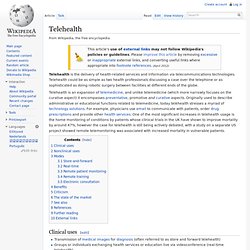
Telehealth could be as simple as two health professionals discussing a case over the telephone or as sophisticated as doing robotic surgery between facilities at different ends of the globe. Telehealth is an expansion of telemedicine, and unlike telemedicine (which more narrowly focuses on the curative aspect) it encompasses preventative, promotive and curative aspects. Originally used to describe administrative or educational functions related to telemedicine, today telehealth stresses a myriad of technology solutions. For example, physicians use email to communicate with patients, order drug prescriptions and provide other health services. Clinical uses[edit] Nonclinical uses[edit] Modes[edit] Store-and-forward[edit]
Advantages of Robotic Surgery. In today's operating rooms, you'll find two or three surgeons, an anesthesiologist and several nurses, all needed for even the simplest of surgeries.
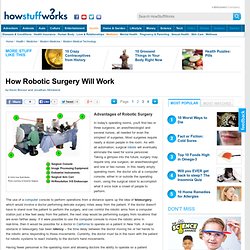
Most surgeries require nearly a dozen people in the room. As with all automation, surgical robots will eventually eliminate the need for some personnel. Taking a glimpse into the future, surgery may require only one surgeon, an anesthesiologist and one or two nurses. In this nearly empty operating room, the doctor sits at a computer console, either in or outside the operating room, using the surgical robot to accomplish what it once took a crowd of people to perform.
The use of a computer console to perform operations from a distance opens up the idea of telesurgery, which would involve a doctor performing delicate surgery miles away from the patient. Having fewer personnel in the operating room and allowing doctors the ability to operate on a patient long-distance could lower the cost of health care in the long term. Robotic Surgery - Minimally Invasive Robotic Surgery with the da Vinci Surgical System. Tele-doctors treat walk-in patients at 4 clinics - Ottawa. Four Appletree Medical Group health clinics in Ottawa are using the internet to connect patients with doctors in Toronto for more timely treatment.
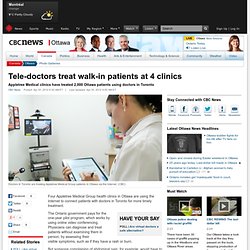
The Ontario government pays for the one-year pilot program, which works by using online video conferencing. Physicians can diagnose and treat patients without examining them in person, by assessing their visible symptoms, such as if they have a rash or burn. Telework Shifts the Bottom Line : HRVoice.org. HRVoice.org | February 8, 2012 | no comments By Natalie Lisik, CDMP Are your employees rolling out of bed, grabbing a cup of java and heading to their office in pajamas?
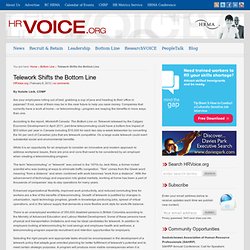
If not, some of them may be in the near future to help you save money. Companies that currently have a work at home—or telecommuting—program are reaping the benefits in more ways than one. According to the report, Workshift Canada: The Bottom Line on Telework released by the Calgary Economic Development in April 2011, part-time telecommuting could have a bottom line impact of $53 billion per year in Canada including $10,000 for each two day-a-week teleworker by converting the 44 per cent of Canadian jobs that are telework compatible.
While it is an opportunity for an employer to consider an innovative and modern approach to address workplace issues, there are pros and cons that need to be considered by an employer when creating a telecommuting program. Weight Loss Punch » Garcinia Cambogia Extract – Dr. Oz Calls Weight Loss Holy Grail. Yes, Dr.

Oz called Garcinia Cambogia Extract (HCA) the Holy Grail of Weight Loss. Gambooge: wikipedia - liver toxicity. Garcinia gummi-gutta is a tropical[2] species of Garcinia native to Indonesia.

Common names include Garcinia cambogia (a former scientific name), as well as brindleberry,[3] Malabar tamarind,[2] and kudam puli (pot tamarind).[4] This fruit looks like a small pumpkin and is green to pale yellow in color. Although it has received considerable media attention purporting its effects on weight loss, there is liver toxicity associated with commercial preparations of the fruit extract[5] with clinical evidence indicating it has no significant effect on weight loss.[6] Unifying Healthcare in Scotland - InterSystems Case Study - TrakCare. Smart clothes for better healthcare. Big data: The next frontier for innovation, competition, and productivity. The amount of data in our world has been exploding, and analyzing large data sets—so-called big data—will become a key basis of competition, underpinning new waves of productivity growth, innovation, and consumer surplus, according to research by MGI and McKinsey's Business Technology Office.
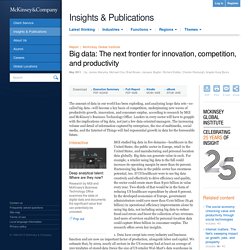
New wave of 'superbugs' poses dire threat, says chief medical officer. Antibiotic-resistant bacteria with the potential to cause untreatable infections pose "a catastrophic threat" to the population, England's chief medical officer warns in a report calling for urgent action worldwide.

Ethics of Implantable Brain Chips. The future may well involve the reality of science fiction's cyborg, persons who have developed some intimate and occasionally necessary relationship with a machine.
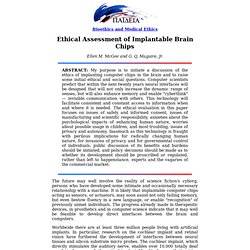
It is likely that implantable computer chips acting as sensors, or actuators, may soon assist not only failing memory, but even bestow fluency in a new language, or enable "recognition" of previously unmet individuals. The progress already made in therapeutic devices, in prosthetics and in computer science indicate that it may well be feasible to develop direct interfaces between the brain and computers. Worldwide there are at least three million people living with artificial implants. In particular, research on the cochlear implant and retinal vision have furthered the development of interfaces between neural tissues and silicon substrate micro probes.